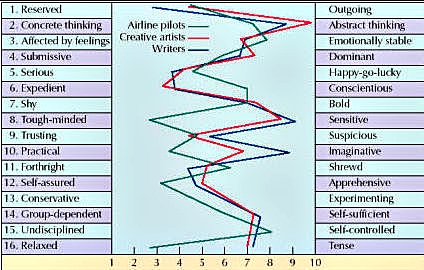Ψlogical
Testing
…Clinical & Counseling
🧹house keeping 🧹
Lectures:
- next exam 4/15
- Chapters 9–16
- YOU will craft items
- slides better? 🤔
Project:
- launch on Thursday
- have convergent measure located prior to class

![]()
☀️ Welcome back!! ❄️


Personality
- Characteristics – “nonintellecitve aspects of human behavior, typically distinguished from mental abilities”
- Traits – “enduring dispositions – tendencies to act, think, or feel in a certain manner”
- Types – “general descriptions of people” \(\leftarrow\) (categories)
- States – “emotional reactions that vary from one situation to another”
Applications in Clinical & Counseling Settings

“Structured”1 Test Construction Strategies
Deductive strategies:
Define the content domain (including the theoretical specification of the construct) and then sample items from that domain
Empirical strategies:
Collect data and leverage statistical associations (typically via correlation and factor analysis) to determine test content (e.g., which items to retain)

![]()
Early Personality Tests1
- Woodworth Personal Data Sheet (Woodworth, 1917) – purpose was to identify unfit military recruits
- 116 yes/no questions
- based on psychiatric interview questions
- one overall score
- Bell Adjustment Inventory (Bell, 1937)
- within different life domains (e.g., work, home)
- Bernreuter Personality Inventory (Bell, 1931)
- 6 different traits assessed
The MMPI (overview)
- identification of major disorders
- true/false self–report
- validity, clinical, & content scales
Note
8 clinical scales, 2 content scales (masculinity–femininity & social–introversion), & 3 validity scales were the original focus of the MMPI.
- validity – information about the person’s approach to testing (e.g., did they try to malinger)
- clinical – identification of psychological disorders (e.g., paranoia, schizophrenia)
- content – descriptive aspects of personality and emotional functioning (e.g., anxiety, anger)
MMPI development
Started with a pool of 1000 items from case histories, psycholigcal reports, textbooks, & other tests.
- 550 items administered to psychiatric patients
- 8 different psychiatric diagnoses
- what items differentiated psychiatric patients from normal population respondents?
Note
The process of using a known sample to determine which items to retain or delete based on empirical associations is also known as empirical keying
MMPI validity scales
What was the test–taker’s attitude & were they honest while responding?
L scale was designed to detect individuals who present themselves in an overly favorable manner
K scale was also designed to detect individuals who present themselves in an overly favorable manner but was empirically keyed
F scale was designed to detect individuals who present themselves disfavorably (aka malingering)
Interpretation
Individual scales did not do a fantastic job of identifying the 8 focal psychological disorders
Clinicians started to look for configural patterns (e.g., Meehl & Dahlstrom, 1960)
Patterns of high (and low) scores across the feedback report constitute a profile
- Might provide more insight regarding presence of disorder

MMPI–2 (Butcher et al., 1989)
Revised to update and expand norms (\(n\)=2,600), revise “out–of–date” items, create a separate form for adolescents, and broaden the item pool (\(k\)=567) as well as number of scales/ constructs
- 460 original items retained (however 68 edited for wording)
- 24 items added for experimental purposes
Note
the MMPI–3 is actually the newest version (Ben-Porath & Tellegen, 2020) – computer administration of 335 items in ~30 minutes
California Psychological Inventory (CPI)
Similar to the MMPI, created via empirical–keying and scored true/ false, however, the intended population here is normally adjusted individuals
The 3rd edition is the most current version (originally created in 1950’s Gough, 1956)
- 36 total scales with hierarchical structure (some of these scales can be combined into higher–order interpretations)
- Two versions available – CPI 434 & CPI 260 (naming is based on the number of items on the inventory)
Factor Analysis
Analytical procedure that helps discover or confirm the dimensionality of your measure (e.g., how many aggregate scales should be created from individual item responses?)
Assumes that underyling traits drive responses to inventory items:

16 PF1
Raymond B Cattell tried using factor analysis to help discover the major dimensions of personality (e.g., how broad is it?) by administering an exhaustive list of 171 adjectives (aka person descriptors)
- factor analysis revealed 16 different dimensions that accounted for agreeing or disaggreeing with the 171 items

Edwards Personal Preference Schedule (EPPS)
Example of a primarily “theoretically–derived”1 personality inventory that retains Murray (1938)’s need system as a theoretical framework (15 specified in EPPS)
Concerned with socially desirable responses, so paired items matched in desirability & asked respondents to select the most descriptive item!!
Warning
This strategy results in some peculiar scoring consequences – every respondent has the same total score, but relative allocation of scores is different (this is referred to as ipsative measurement)
NEO (origins)
Some personality assessments are focused on manifestations of psychopathology (e.g., depression, anxiety, schizophrenia) – an alternative looks for resources an individual is endowed with that may help them successfully navigate the world
- NEO a very popular measure of “positive” personality characteristics
- originally only assessed 3 traits (each with 6 facets )
- Likert–type response options (agreement)

NEO (contemporary)
Structured to assess dimensions (and facets) of the five–factor model of personality
- Conscientiousness
- Agreeableness
- Neuroticism
- Openness to Experience
- Extraversion
Note
Dimension (aka domain) names are reflective of only one pole of construct continuum – each has a corresponding opposing–pole alternative

“Other” positive trait measures
- Rosenberg Self–Esteem Scale (\(k\)=10)
- global feelings of self–worth
- General Self–Efficacy Scale (\(k\)=10)
- belief in own abilities to succeed
- Ego Resiliency Scale Revised (\(k\)=14)
- resilience and emotional intelligence
- Dispositional Resilience Scale (HARDY; \(k\)=45)
- 3 subscales (communication, challenge, control)
- Hope Scale (\(k\)=12)
- 2 scales (pathways, agency)
- Life Orientation Test–Revised (\(k\)=10)
- dispositional optimisim
- Satisfaction with Life Scale (\(k\)=5)
- overall satisfaction/ global well–being
- Positive and Negative Affect Schedule (PANAS; \(k\)=20)
- 2 orthogonal scales
- Coping Intervention for Stressful Situations (\(k\)=48)
- 3 coping styles (task, emotion, avoidance)
- Core Self–Evaluations 😒
A/An ________ is an enduring disposition – a tendency to act, think, or feel in a certain manner
- trait
- type
- state
- construct
Emotional reactions that can vary from one situation to another are referred to as ___________
- states
- traits
- constructs
- domains
The analytical procedure used to determine “how many” scale aggregations are most appropriate is called ____________
- Factor Analysis
- Correlation
- Regression
- Principal Components Analysis
Considered the first personality test, the _____________ aimed to identify unfit military recruits
- Woodworth Personal Data Sheet
- Bell Adjustment Inventory
- Bernreuter Personality Inventory
- Minnesota Multiphasic Personality Inventory
“Configural patterns” across an assessment feedback report are extracted from __________
- profiles
- protrusions
- prominence
- protraction